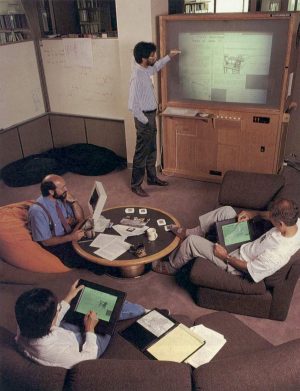The Computer for the 21st Century
Making technology disappear into everyday life
Mark WeiserSummary
In this visionary idea, Mark Weiser introduces the concept of ubiquitous computing — a future where computers are seamlessly integrated into the environment, becoming so commonplace and unobtrusive that they effectively “disappear” from our conscious awareness. Drawing parallels to the omnipresence of written language in modern society, Weiser argues that the most profound technologies are those that weave themselves into the fabric of everyday life until they are indistinguishable from it.
Weiser critiques the prevailing notion of the “personal computer,” suggesting that the focus on individual devices is only a transitional phase. Instead, he imagines a world where computing devices are embedded throughout our surroundings, enhancing our interactions without demanding our attention. These devices support real-world activity without becoming the center of it. Achieving this vision requires rethinking computing itself: moving from screen-based engagement to calm, context-aware technology that aligns with human behavior.
This shift isn’t about creating virtual realities, but about augmenting the real one. It calls for technology designed to align with human psychology and social contexts — helping people focus on their tasks without being encumbered by the tools they use.
The idea of integrating computers seamlessly into the world at large runs counter to a number of present-day trends. “Ubiquitous computing” in this context does not just mean computers that can be carried to the beach, jungle or airport. Even the most powerful notebook computer, with access to a worldwide information network, still focuses attention on a single box. By analogy to writing, carrying a super-laptop is like owning just one very important book. Customizing this book, even writing millions of other books, does not begin to capture the real power of literacy. Mark Weiser
Key concepts
- Ubiquitous computing A vision of computing embedded throughout the environment, allowing users to interact naturally and effortlessly with digital systems that support, rather than interrupt, daily life.
- Embodied virtuality Contrasting with virtual reality, which immerses users in artificial environments, embodied virtuality integrates digital information into the physical world, enhancing real-world experiences rather than replacing them.
- Tabs, pads, and boards Weiser categorizes devices based on their size and function: tiny wearable devices (tabs) that provide brief, context-specific information, portable surfaces (pads) that facilitate more substantial interactions and large, shared displays (boards) that integrate into walls or furniture, supporting group activities and shared information.
- Calm technology Technology that resides in the periphery of our attention, informing us without overwhelming us. It moves between the center and the periphery of our awareness as needed, allowing us to focus on our primary tasks.
Weiser challenges us to rethink our relationship with technology, advocating for a future where computing is seamlessly integrated into our lives, enhancing our experiences without becoming a focal point. By embedding technology into the fabric of daily life, ubiquitous computing aims to create a more intuitive, supportive and less intrusive digital world.

This idea was originally published as “The Computer for the 21st Century” in Scientific American, Vol. 265, No. 3 (September 1991), p. 94.
Big Idea Initiative is all about making connections, and sharing knowledge, thoughts, and ideas that support deep thinking and collaboration. Our goal is to create a space that sparks thinking and conversations among people whose ideas might benefit each other, even if they’re working on completely unrelated topics. We think that pushing back the limits of possibility will come as a result of the connections that diverse collaborators make together. Identifying these connections will bring the big ideas our world needs.
We need your help! If you…
- have questions or feedback about this work
- want to improve, develop, or add to this idea
- want to sponsor a prototype of this idea
we invite you to contact us: hello@bigideainitiative.org.